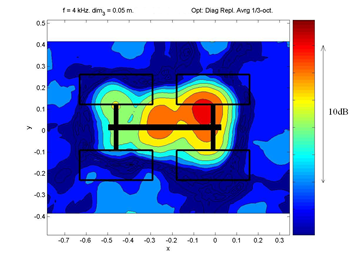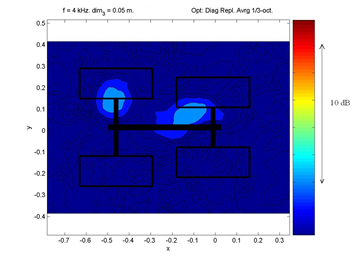The aim of this research is to develop accurate acoustic array measurement techniques for use in closed-section wind tunnels. This is for research and development work, such as for aircraft components, and also to provide better methods that can be used for full aircraft wind tunnel test programmes.
This work successfully developed microphone array systems that are now extensively used by the ANTC at Southampton and in the Airbus low-speed wind tunnel in Filton, UK.
Our research is focused on techniques to remove the reverberation effects encountered in closed-section wind tunnel testing. The overall aim is to improve methods so that this testing is accurate enough to be used to provide certification checking as an integral part of any aircraft wind tunnel test programme.
Microphone arrays are used to provide sound source location maps of aircraft components and whole airframes. This technology is well-developed for flyover and open-jet wind tunnel testing. Closed-section tunnels, used extensively in aerodynamic test programmes, are highly reverberant, making them less suitable for aeroacoustic measurements. This project aims to develop microphone array techniques specifically tailored for measurements in closed-section wind tunnels. This is to ultimately enable aircraft noise certification tests to be carried out alongside aerodynamic testing during the whole lifecycle of an aircraft development programme. The figure below shows the first aeroacoustic test of an airliner ever carried out in the Airbus Filton low-speed tunnel, using the Southampton microphone array system.
The aims of this project are twofold:
Develop and deploy microphone array systems for sound source location and level measurement in closed-section wind tunnels for ANTC and Airbus.
Develop advanced processing techniques to remove the effects of reverberation, and provide truly accurate sound source level measurements for aircraft development programmes.

Figure 1: Microphone array measurements of a landing gear in the Southampton tunnel.
The focussed beamformer is a proven technique for deriving sound source localisation maps. An array of microphones flush-mounted in the wind tunnel wall enable unobtrusive testing. The principle of operation is to apply a phase shift to the signals from each microphone, effectively making the array selective to sound from a particular point in space.
The focussed beamformer relies on a Green’s function (or steering vector) to compute the sound source strengths. A free-space Green’s function is usually used, as in open-jet and flyover testing. Using this in a reverberant closed-section wind tunnel environment leads to significant errors in predicted sound source level. This research is developing new techniques to refine the Green’s function to take into account reverberation effects. Recent results indicate significant improvements in accuracy over use of a free-space Green’s function. This work is ongoing, and includes developing Inverse Methods to take into account dipole and quadrupole sound sources.

Figure 2 : Microphone array measurements of a landing gear in the Southampton tunnel

Figure 3 : Microphone array measurements of a landing gear in the Southampton tunnel
This project has successfully developed microphone array technology for closed-section testing at the ANTC and Airbus. It is an ongoing research effort to ultimately provide certification level accuracy.